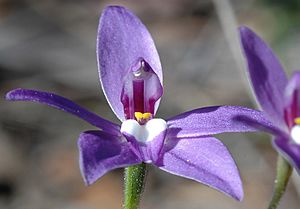Waxlip orchid facts for kids
Quick facts for kids Waxlip orchid |
|
|---|---|
 |
|
| Caladenia major growing in Tasmania | |
| Scientific classification | |
| Genus: |
Caladenia
|
| Species: |
major
|
| Synonyms | |
|
Glossodia major R.Br. |
|
The Caladenia major, often called the waxlip orchid, is a special plant. People also know it as the parson-in-the-pulpit or purple cockatoo. It belongs to the orchid family and grows only in Australia.
This orchid grows from the ground. It has one fuzzy leaf and usually one or two purple flowers. For many years, it was known as Glossodia major. This name was given by a Scottish botanist named Robert Brown in 1810. However, new discoveries show it is part of the Caladenia group.
What the Waxlip Orchid Looks Like
The Waxlip orchid is a plant that lives for many years (it's a perennial). It grows from an underground storage part called a tuber. This plant loses its leaves each year (it's deciduous).
It has one dark green leaf that feels hairy. The leaf is shaped like a long oval, about 30 to 60 mm (1.2 to 2.4 inches) long. It is about 15 to 20 mm (0.6 to 0.8 inches) wide.
One or two flowers grow on a stem that is 80 to 350 mm (3 to 14 inches) tall. The flowers have a light smell. They are about 30 to 45 mm (1.2 to 1.8 inches) long and wide.
The outer parts of the flower, called sepals and petals, are purple or mauve. Their bottoms are white with purple spots. Sometimes, the flowers are all white.
The top sepal is 18 to 25 mm (0.7 to 1.0 inch) long. The side sepals are also 18 to 25 mm long. They spread out to the sides. The petals are 16 to 20 mm (0.6 to 0.8 inches) long and spread wide.
The special lip-shaped petal, called the labellum, is 7 to 10 mm (0.3 to 0.4 inches) long. It is white with a purple tip and has a groove down the middle. At the base of the labellum, there is a purple, tube-shaped part. It has two yellow, soft bumps on top. These orchids usually bloom from August to November.
How the Waxlip Orchid Got Its Name
The Waxlip orchid was first officially described in 1810. This was done by Robert Brown. He named it Glossodia major. He wrote about it in a book called Prodromus Florae Novae Hollandiae.
In 2015, scientists studied the plant's DNA (this is called molecular phylogenetics). Because of these studies, a scientist named Mark Clements changed its name. He renamed it Caladenia major. The second part of the name, major, is a Latin word. It means "greater."
Today, Glossodia major is seen as an older name for Caladenia major. The Royal Botanic Gardens, Kew accepts the name Caladenia major.
Where Waxlip Orchids Grow
Caladenia major grows in many parts of Australia. You can find it in all states except Western Australia and the Northern Territory.
- In New South Wales, it is common in the eastern half of the state.
- In Victoria, it is also common in most places where it can grow.
- In South Australia, it is common in the southeast. Sometimes, many of these orchids grow together there.
- In Tasmania, it is common and found in many areas.
- In Queensland, it grows in the southeast part of the state.
This orchid can be found in different places. These include coastal heathlands, woodlands, and dry open forests.

